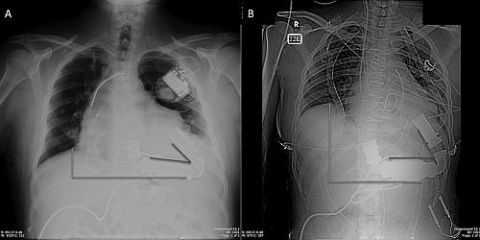Surgical Technique Influences Left Ventricular Assist Device Thrombosis
Temple University School of Medicine, Philadelphia, PA
Yale University School of Medicine, New Haven, CT
Meeting: 2013 American Transplant Congress
Abstract number: C1442
Purpose: Left ventricular assist devices are effective for bridging patients to cardiac transplantation. Thrombosis of Heartmate-2 (HM2) is a potentially devastating complication. While attention has been focused on anticoagulation strategies to prevent this complication, the goal of this study was to study the impact of surgical technique on HM2 thrombosis.
Methods: Forty-nine patients undergoing HM2 implantation at 2 institutions were retrospectively reviewed. Pump thrombosis (PT) was defined as presence of thrombus in the HM2 stator and/or rotor at explant or autopsy, with >30% elevation in pump power, >30% elevation in LDH, and >20% decrease in hemoglobin. A blinded clinician reviewed dimensions and angles of the HM2 obtained from chest x-rays. Patients demonstrating PT were compared to those with normal flow (NF).
Results: Of the 49 patients reviewed, 11 (22.4%) displayed evidence of PT at a median of 42 days after HM2 implantation. Patient with PT had a significantly greater acute angulation of the HM2 inflow cannula immediately post-operation (48.2 vs. 65.4, p<0.001) and after 30 days (50.1±8.0 vs. 65.1±9.9 degrees, p<0.001). Pump pocket depth was significantly lower in the PT group immediately after HM-2 implantation (107.0 vs. 144.3 cm, p<0.001) and after 30 days (86.0±39.1 vs. 113.1±25.4 cm, p=0.02). Patients with evidence of PT did not have a significant decrease in end-diastolic diameter (76±9 vs. 70±15 mm, p=0.24) while those in the NF group had effective remodeling of the left ventricle (70±10 vs. 56±12 mm, p=0.01). A poorly placed device in a patient with pump thrombosis (A) is shown along with an ideally placed pump pocket (B) with gentle angulation of the inflow cannula and deeply placed pump pocket.

Conclusions: Meticulous surgical technique, which necessitates creating an adequately sized pump pocket and appropriately directing the inflow cannula at the time of operation, may reduce the risk of PT.
To cite this abstract in AMA style:
Taghavi S, Ward C, Jayarajan S, Gaughan J, Wilson L, Mangi A. Surgical Technique Influences Left Ventricular Assist Device Thrombosis [abstract]. Am J Transplant. 2013; 13 (suppl 5). https://atcmeetingabstracts.com/abstract/surgical-technique-influences-left-ventricular-assist-device-thrombosis/. Accessed December 14, 2025.« Back to 2013 American Transplant Congress
